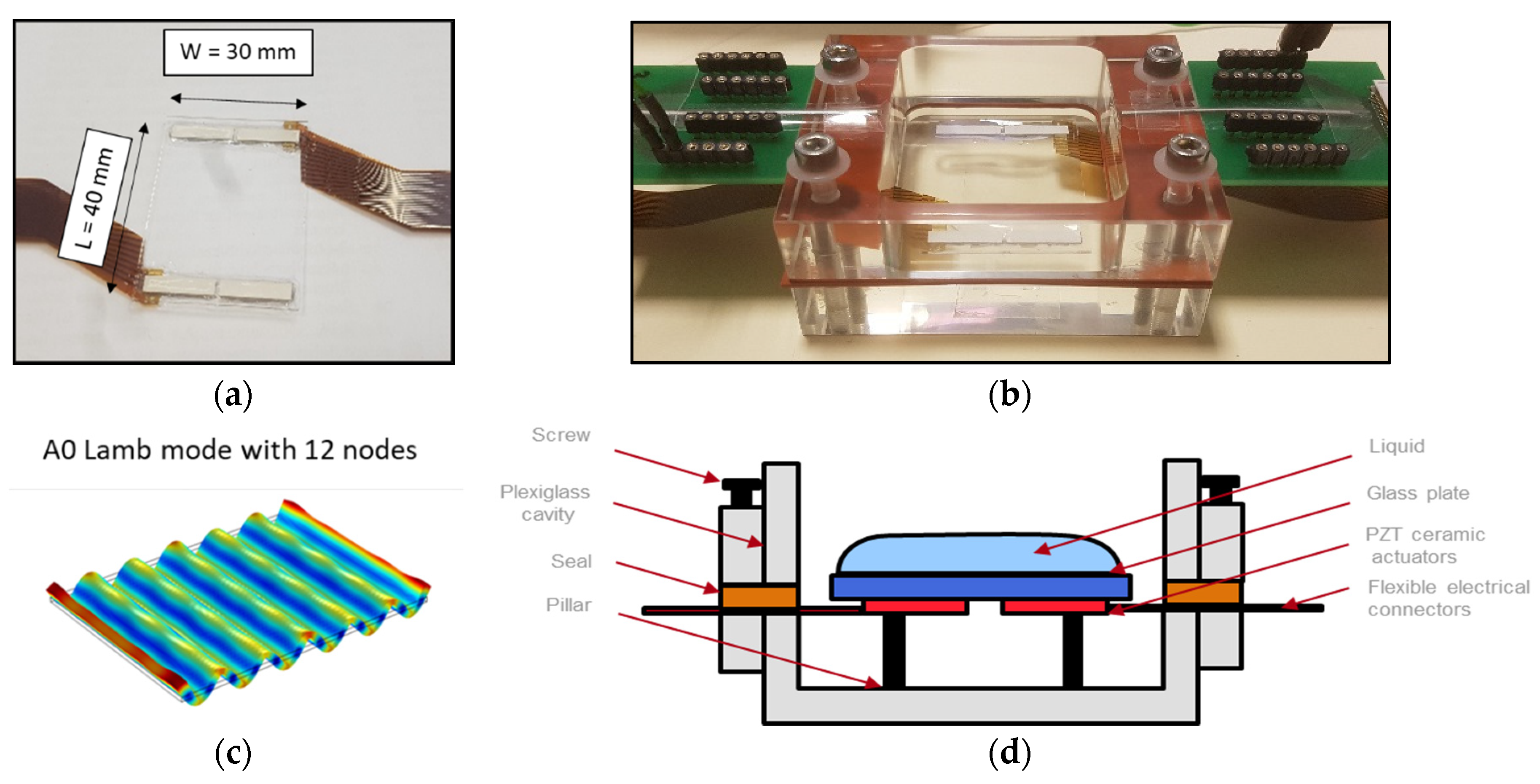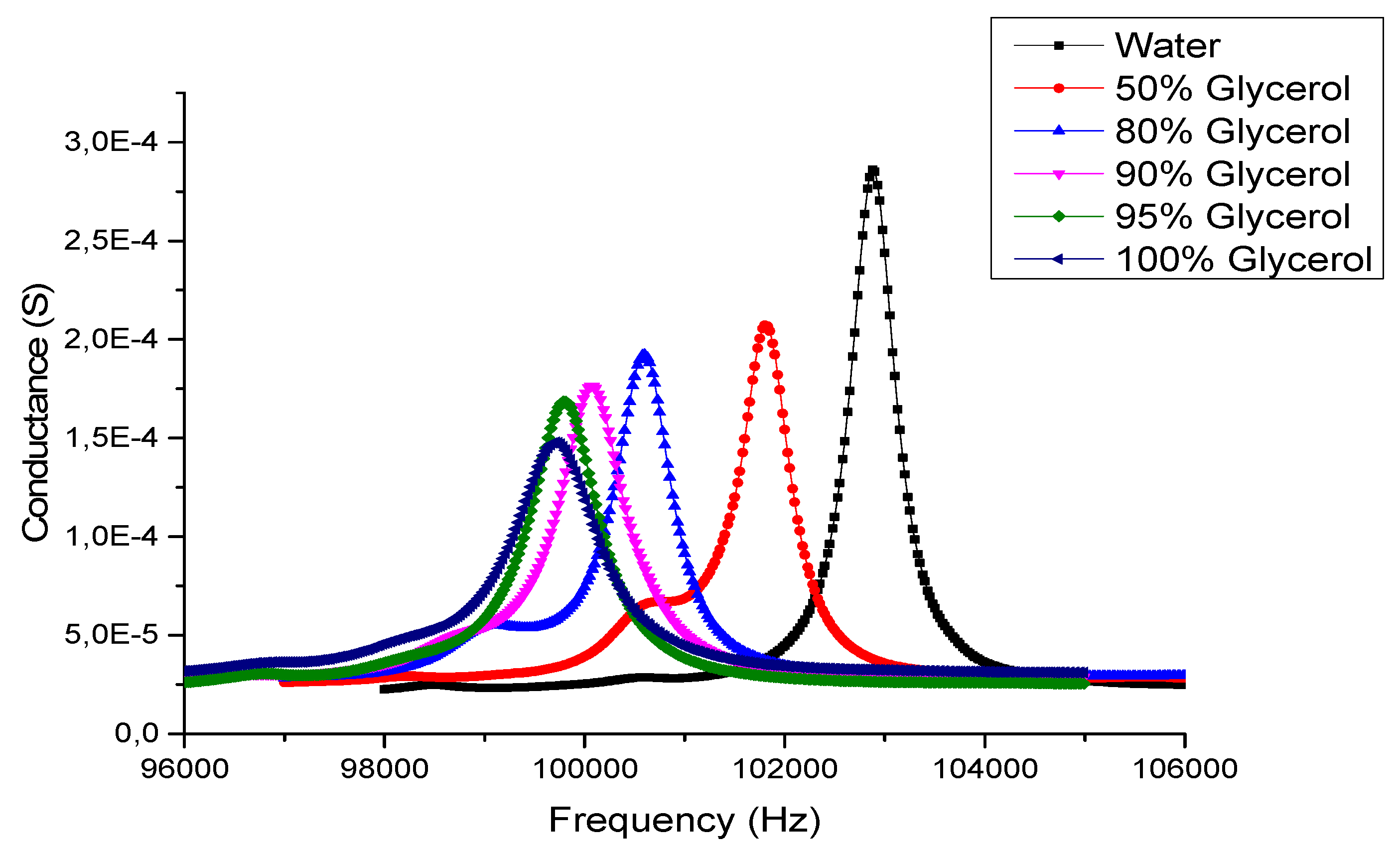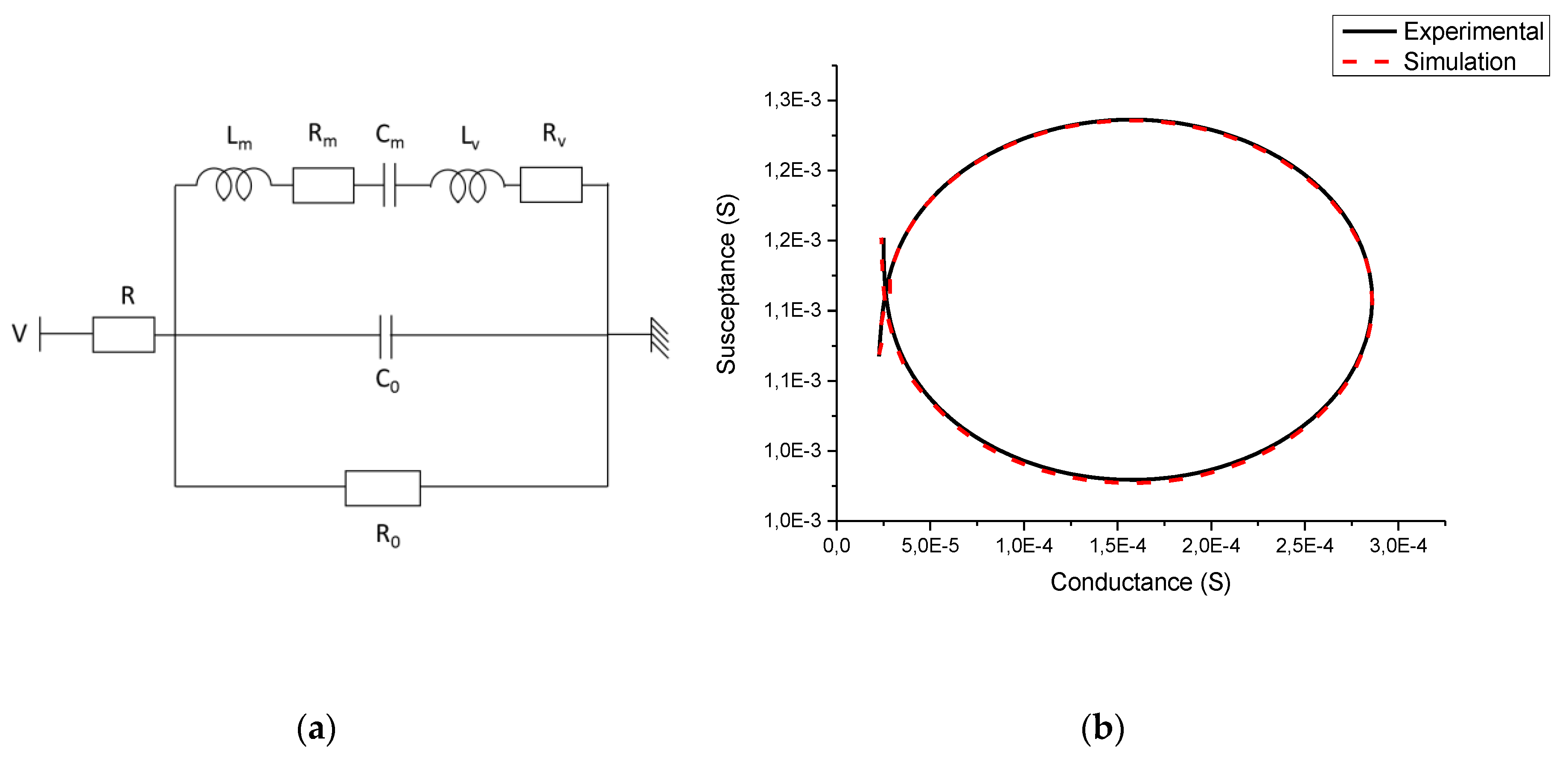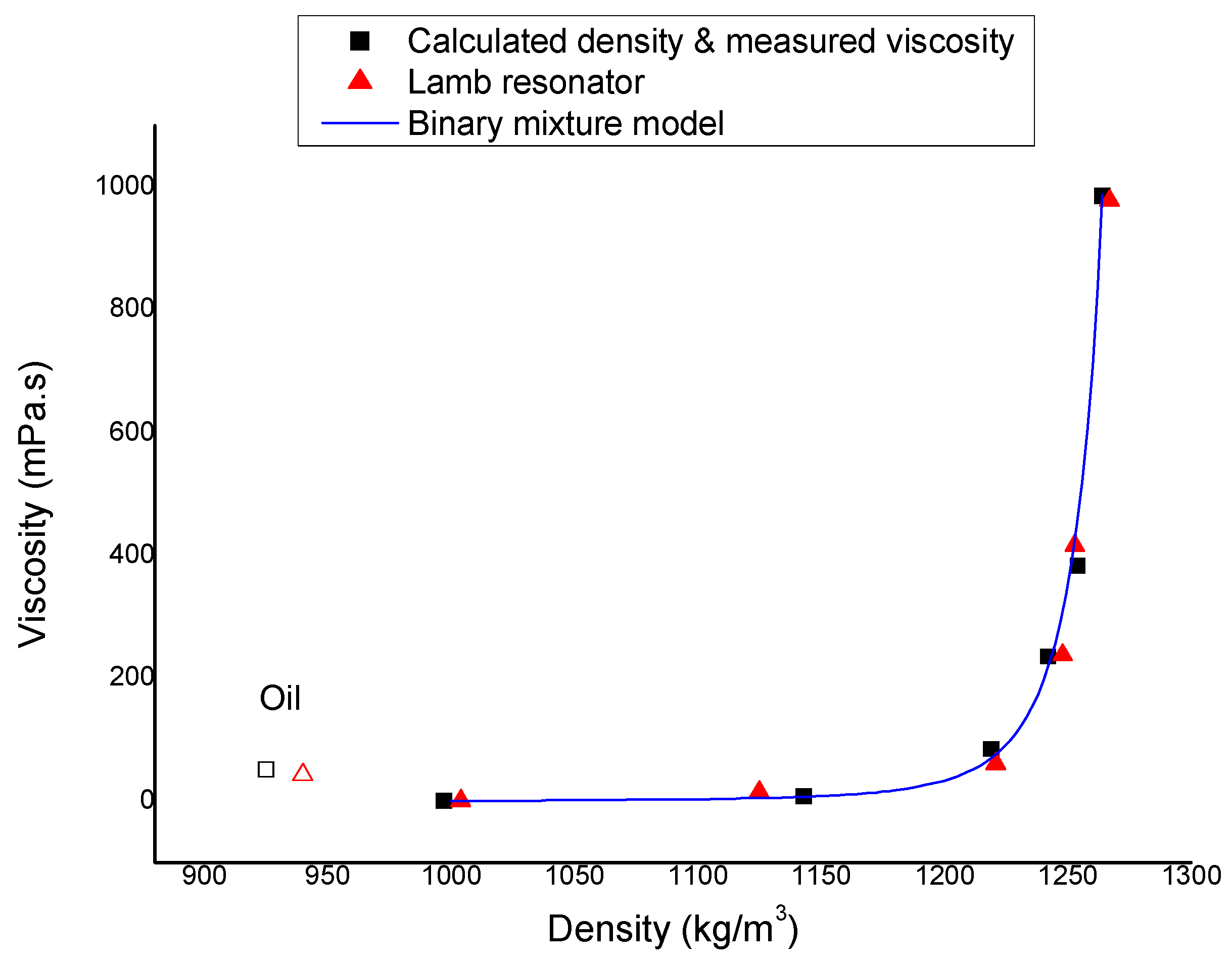Piezoelectric Actuated Glass Plate for Liquid Density and Viscosity Measurement
Abstract
1. Introduction
2. Materials and Methods
3. Results
4. Discussion
5. Conclusions
Author Contributions
Funding
Acknowledgments
Conflicts of Interest
References
- Toledo, J.; Jiménez-Márquez, F.; Úbeda, J.; Ruiz-Díez, V.; Pfusterschmied, G.; Schmid, U.; Sánchez-Rojas, J.L. Piezoelectric MEMS resonators for monitoring grape must fermentation. J. Phys. Conf. Ser. 2016, 757, 012020. [Google Scholar] [CrossRef]
- Phillips, L.G.; Mcgiff, M.L.; Barbano, D.M.; Lawless, H.T. The Influence of Fat on the Sensory Properties, Viscosity, and Color of Lowfat Milk1. J. Dairy Sci. 1995, 78, 1258–1266. [Google Scholar] [CrossRef]
- Osterhold, M. Rheological methods for characterising modern paint systems. Prog. Org. Coat. 2000, 40, 131–137. [Google Scholar] [CrossRef]
- Amund, O.O.; Adebiyi, A.G. Effect of viscosity on the biodegradability of automotive lubricating oils. Tribol. Int. 1991, 24, 235–237. [Google Scholar] [CrossRef]
- Wu, Z.; Ma, X. Dynamic analysis of submerged microscale plates: The effects of acoustic radiation and viscous dissipation. Proc. R. Soc. A Math. Phys. Eng. Sci. 2016, 472, 20150728. [Google Scholar] [CrossRef]
- Jakoby, B.; Vellekoop, M.J. Physical Sensors for Liquid Properties. IEEE Sens. J. 2011, 11, 3076–3085. [Google Scholar] [CrossRef]
- Lu, X.; Hou, L.; Zhang, L.; Tong, Y.; Zhao, G.; Cheng, Z.-Y. Piezoelectric-excited membrane for liquids viscosity and mass density measurement. Sens. Actuators A Phys. 2017, 261, 196–201. [Google Scholar] [CrossRef]
- Coleman, M.M. Fundamentals of Polymer Science: An introductory Text; Routledge: Abingdon-on-Thames, UK, 2019; ISBN 1-351-44639-8. [Google Scholar]
- Roiter, Y.; Minko, S. AFM Single Molecule Experiments at the Solid−Liquid Interface: In Situ Conformation of Adsorbed Flexible Polyelectrolyte Chains. J. Am. Chem. Soc. 2005, 127, 15688–15689. [Google Scholar] [CrossRef]
- Hadji, C.; Virot, L.; Picard, C.; Baléras, F.; Agache, V. MEMS with an embedded fluidic microchannel for sensitive weighing of liquid samples. In Proceedings of the 2017 IEEE 30th International Conference on Micro Electro Mechanical Systems (MEMS), Las Vegas, NV, USA, 22–26 January 2017; IEEE: Piscataway, NJ, USA, 2017; pp. 1001–1004. [Google Scholar]
- Khan, M.F.; Schmid, S.; Larsen, P.E.; Davis, Z.J.; Yan, W.; Stenby, E.H.; Boisen, A. Online measurement of mass density and viscosity of pL fluid samples with suspended microchannel resonator. Sens. Actuators B Chem. 2013, 185, 456–461. [Google Scholar] [CrossRef]
- Lee, I.; Lee, J. Quality factor and vibration amplitude based viscosity measurements using suspended microchannel resonators. In Proceedings of the IEEE Sensors, Taipei, Taiwan, 28–31 October 2012; pp. 1–4. [Google Scholar]
- Casset, F.; Danel, J.S.; Chappaz, C.; Civet, Y.; Amberg, M.; Gorisse, M.; Dieppedale, C.; Le Rhun, G.; Basrour, S.; Renaux, P.; et al. Low voltage actuated plate for haptic applications with PZT thin-film. In Proceedings of the 2013 Transducers & Eurosensors XXVII: The 17th International Conference on Solid-State Sensors, Actuators and Microsystems (TRANSDUCERS & EUROSENSORS XXVII), Barcelona, Spain, 16–20 June 2013; pp. 2733–2736. [Google Scholar]
- Wang, G.; Li, F. An Online Viscosity Measurement Method Based on the Electromechanical Impedance of a Piezoelectric Torsional Transducer. IEEE Sens. J. 2018, 18, 8781–8788. [Google Scholar] [CrossRef]
- Lucklum, F.; Reichel, E.K.; Jakoby, B. Miniature density–viscosity measurement cell utilizing electrodynamic-acoustic resonator sensors. Sens. Actuators A Phys. 2011, 172, 75–81. [Google Scholar] [CrossRef]
- Ayela, C.; Nicu, L. Micromachined piezoelectric membranes with high nominal quality factors in newtonian liquid media: A Lamb’s model validation at the microscale. Sens. Actuators B Chem. 2007, 123, 860–868. [Google Scholar] [CrossRef]
- Manzaneque, T.; Ruiz, V.; Hernando-García, J.; Ababneh, A.; Seidel, H.; Sánchez-Rojas, J.L. Characterization and simulation of the first extensional mode of rectangular micro-plates in liquid media. Appl. Phys. Lett. 2012, 101, 151904. [Google Scholar] [CrossRef]
- Castille, C.; Dufour, I.; Lucat, C. Longitudinal vibration mode of piezoelectric thick-film cantilever-based sensors in liquid media. Appl. Phys. Lett. 2010, 96, 154102. [Google Scholar] [CrossRef]
- Manzaneque, T.; Ruiz-Díez, V.; Hernando-García, J.; Wistrela, E.; Kucera, M.; Schmid, U.; Sánchez-Rojas, J.L. Density-viscosity sensor based on piezoelectric MEMS resonator and oscillator circuit. In Proceedings of the IEEE Sensors 2014, Valencia, Spain, 2–5 November 2014; pp. 241–244. [Google Scholar]
- Cox, R.; Josse, F.; Heinrich, S.M.; Brand, O.; Dufour, I. Characteristics of laterally vibrating resonant microcantilevers in viscous liquid media. J. Appl. Phys. 2012, 111, 014907. [Google Scholar] [CrossRef]
- McLoughlin, N.; Lee, S.L.; Hähner, G. Simultaneous determination of density and viscosity of liquids based on resonance curves of uncalibrated microcantilevers. Appl. Phys. Lett. 2006, 89, 184106. [Google Scholar] [CrossRef]
- Ducrot, P.-H.; Dufour, I.; Nicu, L.; Mathieu, F.; Ayela, C. Full system for piezoelectric organic MEMS resonators operating in liquid media. In Proceedings of the Solid-State Sensors, Actuators and Microsystems (TRANSDUCERS), 2017 19th International Conference on IEEE, Kaohsiung, Taiwan, 18–22 June 2017; pp. 1372–1375. [Google Scholar]
- Tamayo, J.; Humphris, A.D.L.; Malloy, A.M.; Miles, M.J. Chemical sensors and biosensors in liquid environment based on microcantilevers with amplified quality factor. Ultramicroscopy 2001, 86, 167–173. [Google Scholar] [CrossRef]
- Peiker, P.; Klingel, S.; Menges, J.; Bart, H.-J.; Oesterschulze, E. A Partially Wettable Micromechanical Resonator for Chemical- and Biosensing in Solution. Procedia Eng. 2016, 168, 606–609. [Google Scholar] [CrossRef]
- Linden, J.; Thyssen, A.; Oesterschulze, E. Suspended plate microresonators with high quality factor for the operation in liquids. Appl. Phys. Lett. 2014, 104, 191906. [Google Scholar] [CrossRef]
- Linden, J.; Oesterschulze, E. Improving the quality factor of cantilevers in viscous fluids by the adaptation of their interface. Appl. Phys. Lett. 2012, 100, 113511. [Google Scholar] [CrossRef]
- Kucera, M.; Wistrela, E.; Pfusterschmied, G.; Ruiz-Díez, V.; Manzaneque, T.; Hernando-García, J.; Sánchez-Rojas, J.L.; Jachimowicz, A.; Schalko, J.; Bittner, A.; et al. Design-dependent performance of self-actuated and self-sensing piezoelectric-AlN cantilevers in liquid media oscillating in the fundamental in-plane bending mode. Sens. Actuators B Chem. 2014, 200, 235–244. [Google Scholar] [CrossRef]
- Wilkie-Chancellier, N.; Martinez, L.; Serfaty, S.; Griesmar, P. Lamb wave sensor for viscous fluids characterization. IEEE Sens. J. 2009, 9, 1142–1147. [Google Scholar] [CrossRef]
- Pfusterschmied, G.; Kucera, M.; Steindl, W.; Manzaneque, T.; Díez, V.R.; Bittner, A.; Schneider, M.; Sánchez-Rojas, J.L.; Schmid, U. Roof tile-shaped modes in quasi free–free supported piezoelectric microplate resonators in high viscous fluids. Sens. Actuators B Chem. 2016, 237, 999–1006. [Google Scholar] [CrossRef]
- Yu, L.; Tian, Z. Case study of guided wave propagation in a one-side water-immersed steel plate. Case Stud. Nondestruct. Test. Eval. 2015, 3, 1–8. [Google Scholar] [CrossRef]
- Zhu, Z.; Wu, J.; Li, J.; Zhou, W. A general dispersion relation for Lamb-wave sensors with liquid-layer loading. Sens. Actuators A Phys. 1995, 49, 79–84. [Google Scholar] [CrossRef]
- Brissaud, M. Matériaux Piézoélectriques: Caractérisation, Modélisation et Vibration; Sciences Appliquées INSA Lyon; Presses Polytechniques et Universitaires Romandes: Lyon, France, 2007; ISBN 978-2-88074-692-6. [Google Scholar]
- Heinisch, M. Mechanical Resonators for Liquid Viscosity and Mass Density Sensing. Ph.D. Thesis, Université de Bordeaux, Bordeaux, France, 2015. [Google Scholar]
- Heinisch, M.; Voglhuber-Brunnmaier, T.; Reichel, E.K.; Dufour, I.; Jakoby, B. Reduced order models for resonant viscosity and mass density sensors. Sens. Actuators A Phys. 2014, 220, 76–84. [Google Scholar] [CrossRef]
- Toledo, J.; Ruiz-Díez, V.; Pfusterschmied, G.; Schmid, U.; Sánchez-Rojas, J.L. Calibration procedure for piezoelectric MEMS resonators to determine simultaneously density and viscosity of liquids. Microsyst. Technol. 2018, 24, 1423–1431. [Google Scholar] [CrossRef]





| Tested Liquids | Calculated Density (kg/m3) | Measured Dynamic Viscosity (mPa·s) |
|---|---|---|
| Water | 997.1 | 1.22 |
| 50% Glycerol | 1143 | 8.5 |
| 80% Glycerol | 1219 | 85.3 |
| 90% Glycerol | 1242 | 236 |
| 95% Glycerol | 1254 | 383 |
| 100% Glycerol | 1264 | 985 |
| Tested Liquids | Resonance Frequency (Hz) | Quality Factor |
|---|---|---|
| Water | 103,376 ± 485 | 163 ± 31 |
| 50% Glycerol | 101,833 ± 25 | 139 ± 19 |
| 80% Glycerol | 100,610 ± 75 | 131 ± 10 |
| 90% Glycerol | 100,140 ± 79 | 113 ± 6 |
| 95% Glycerol | 99,825 ± 43 | 111 ± 8 |
| 100% Glycerol | 99,763 ± 86 | 93 ± 2 |
© 2020 by the authors. Licensee MDPI, Basel, Switzerland. This article is an open access article distributed under the terms and conditions of the Creative Commons Attribution (CC BY) license (http://creativecommons.org/licenses/by/4.0/).
Share and Cite
Neff, B.; Casset, F.; Millet, A.; Agache, V.; Colin, M. Piezoelectric Actuated Glass Plate for Liquid Density and Viscosity Measurement. Micromachines 2020, 11, 348. https://doi.org/10.3390/mi11040348
Neff B, Casset F, Millet A, Agache V, Colin M. Piezoelectric Actuated Glass Plate for Liquid Density and Viscosity Measurement. Micromachines. 2020; 11(4):348. https://doi.org/10.3390/mi11040348
Chicago/Turabian StyleNeff, Baptiste, Fabrice Casset, Arnaud Millet, Vincent Agache, and Mikael Colin. 2020. "Piezoelectric Actuated Glass Plate for Liquid Density and Viscosity Measurement" Micromachines 11, no. 4: 348. https://doi.org/10.3390/mi11040348
APA StyleNeff, B., Casset, F., Millet, A., Agache, V., & Colin, M. (2020). Piezoelectric Actuated Glass Plate for Liquid Density and Viscosity Measurement. Micromachines, 11(4), 348. https://doi.org/10.3390/mi11040348






